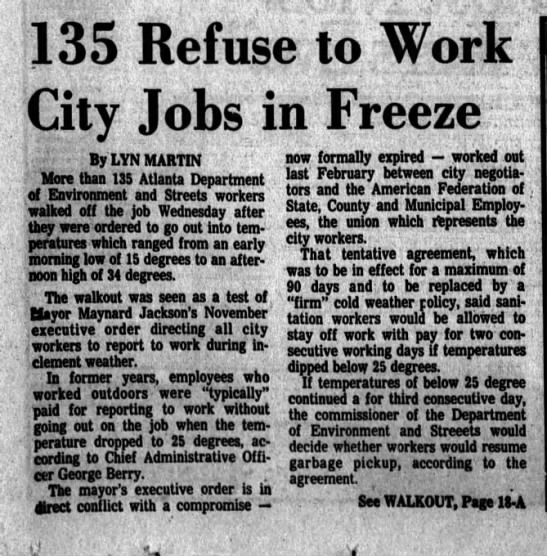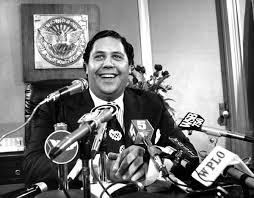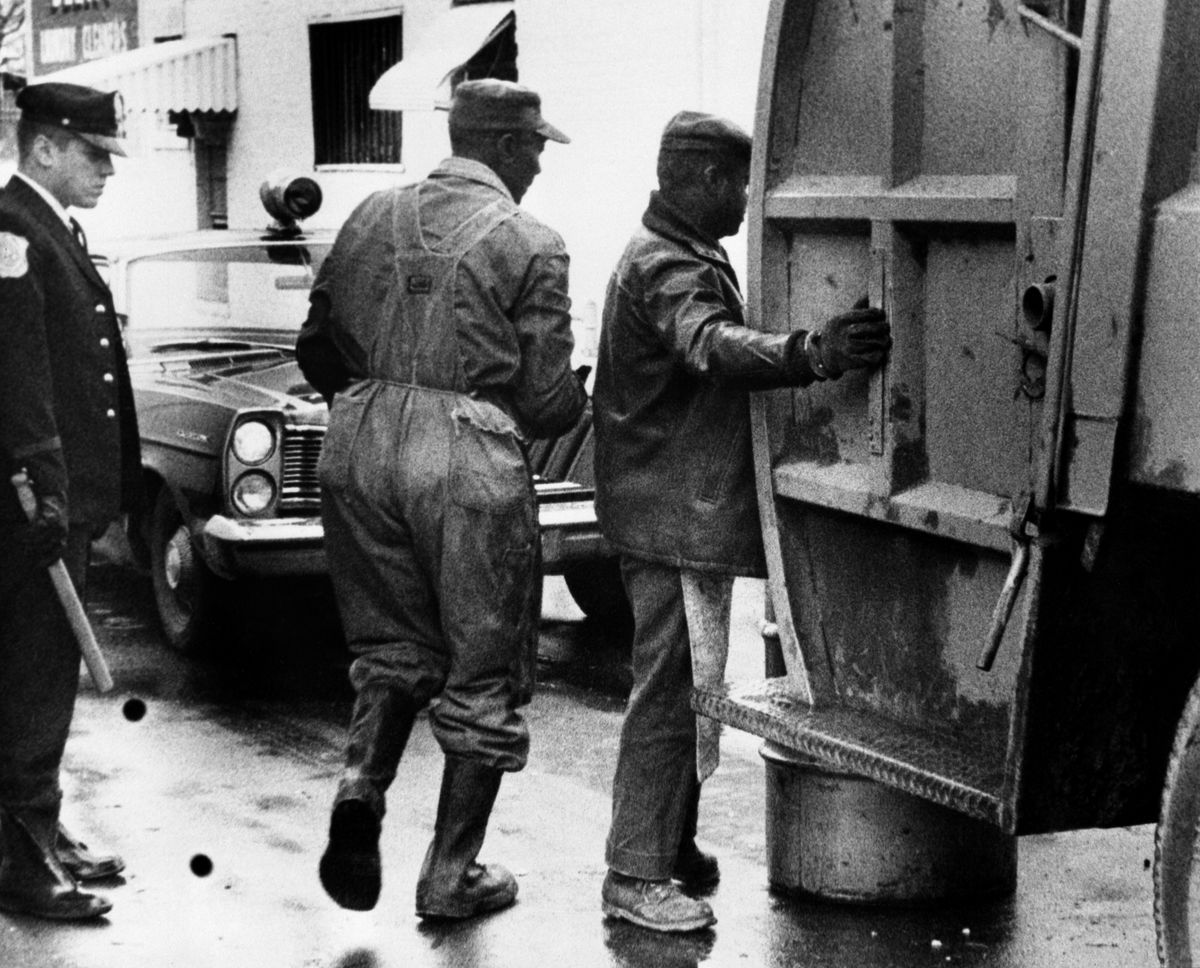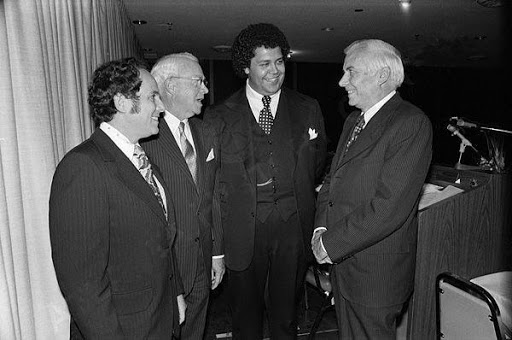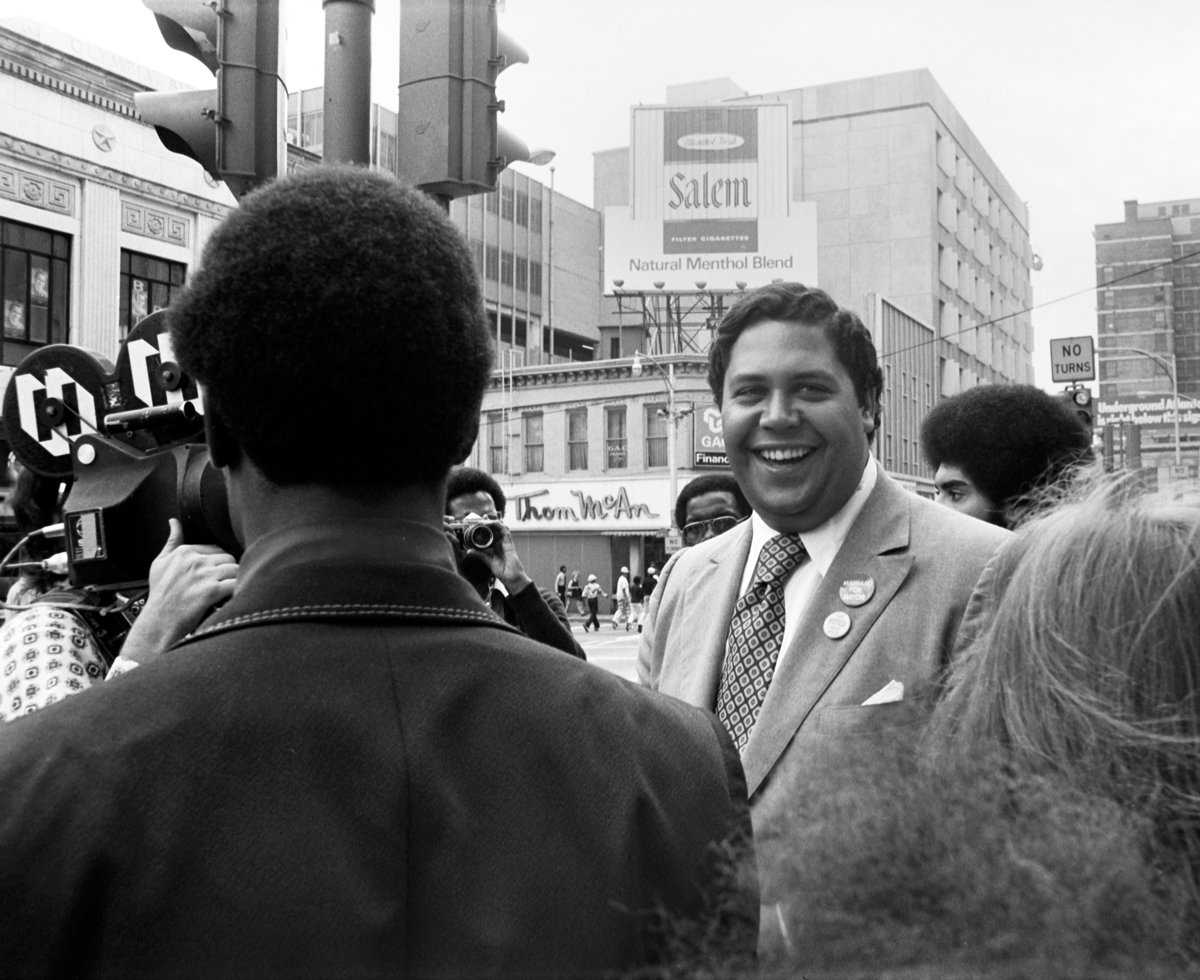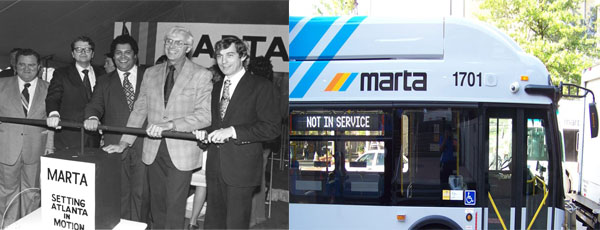STRIKING BLACK SANITATION WORKERS VS. BLACK OFFICIALDOM IN 1977 ATLANTA RE-EXAMINED PART 2
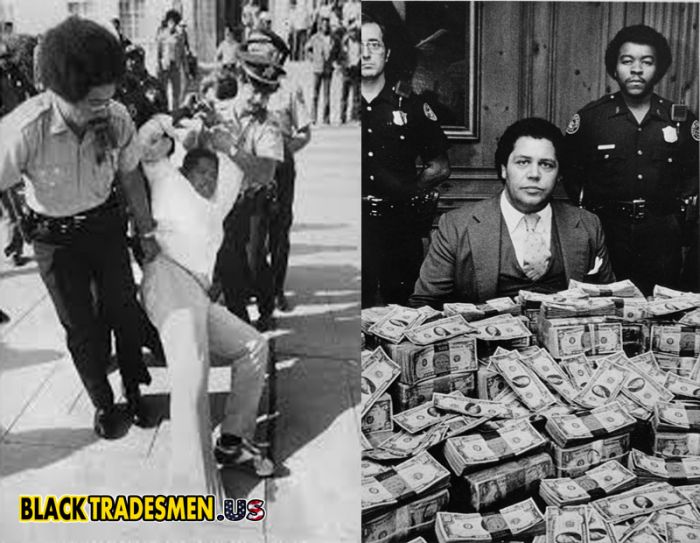
ATLANTA STRIKE OF 1977
The sanitation workers strike of 1977 was a culmination of frustrating and contradictory relations with a new generation of ruling elites. Pivotal was the relationship between city workers, represented by AFSCME Local 1644, and Mayor Maynard Jackson. This relationship began in 1970 when sanitation workers struck for union recognition, higher wages, and change in the unequal social relations between city management and rank-and-file employees. Their demands mirrored those of striking sanitation workers in Memphis just two years earlier. Atlanta’s white mayor, Sam Massell, battled back by firing workers and using prisoners from city jails for garbage removal.[5]
Jackson, then vice-mayor and a former lawyer with the National Labor Relations Board (NLRB), publicly chastised Massell’s hard line tactics, supporting those on strike and calling their wages “a disgrace before God.”[6] This endeared Jackson to city workers, progressive whites, and many folks in the black community who helped elect him mayor in 1973. However it was Jackson who, by March 1977, became a “disgrace before God” in the eyes of those same city sanitation workers he supported in 1970, and who got out the vote for him two years later.
This contradiction showed Jackson’s success in preempting popular black support for the 1977 strike by municipal sanitation workers, nearly all of whom were black and who were easily the lowest-paid workers on the city government’s payroll. Jackson short-circuited union and worker attempts to build community support for the strike by portraying it as a racial attack by a white-led AFSCME on his administration. This, even though most of its local union leaders were black and had struck against the initial wishes of many whites in the union’s national leadership.[7]
This relationship helped form the foundations of social relations between largely black-run city government and everyday black folks they governed. This was the logical outcome of civil rights and Black Power struggles for self-government, for these movements at their philosophical core sought a seat at the table of representative democracy, rather than turning that table over in favor of a democracy from below. For many everyday black folks Maynard Jackson represented Black Power, and they believed his rise to power meant the city’s social and economic patronage circles would trickle down to them.
In the minds of the new black officials and perhaps the majority of working folks in the black community, the actions of striking sanitation workers threatened what they believed was Black Power finally achieved. The perceived gains for the black community would not be uprooted by class struggle under the watch of black officials and their supporters. This relationship continues today in Atlanta, where black officials receive wide support among folks of various class and ethnic backgrounds throughout the city.
The 1977 strike occurred in two separate waves. The first played out during four weeks in January and February. It began with sanitation men wildcatting when they were told to report to work in cold weather conditions. The city and union had agreed employees did not have to work if the temperature was below 25 degrees, which it was on the 18th and 19th of January. City bosses ignored this agreement and docked employee pay.
Already upset their demands for higher wages were falling on deaf ears, many sanitation workers walked off the job for a week in February when city officials refused to reinstate pay.[8] Jackson and city officials refused to give in, demanding employees return to work or face termination. The move caused the ranks to waiver, with the majority of AFSCME Local 1644 staying on the job. A solidarity strike among waterworks employees also failed to materialize.
The city agreed to pay only half the wages docked. AFSCME local organizer Leamon Hood said the strike was not so much about the pay as “the principle of someone sitting in a warm office and telling you to go out in cold weather when you couldn’t even get the ice off the cans.”[9] It was the idea that sanitation workers should manage their workplace of their own accord, free of bosses sitting in the warm offices of city hall.
Another theme evident was that bosses failed to follow agreed upon work stipulations, and held it against workers when they dare follow the rules. This demonstrated the contempt city bosses had towards any terms of the contract or any other agreements favorable to working folks, showing how tenuous labor-management contracts really are. Won through the struggle and self-activity of workers, not dreamt from the minds of labor bureaucrats, contracts that supposedly govern workplace social conditions are never set in stone. Their gains must constantly be guarded by working folks against bosses who would assume they never existed in the first place. The strikes of January and February would serve as a prelude to events occurring some weeks later.
Bitter and emboldened by their experience in January and February, sanitation workers and AFSCME Local 1644 continued pressing the Jackson administration for fifty-cent-per-hour wage increases to a salary averaging $7,000 annually. This amount was below the national poverty line. Jackson refused, claiming raises would put the city budget into deficit. With Jackson up for reelection and seeking to shore up support among white business elites and middle classes, he did not want to be the first mayor since 1937 to take the city to the bank.[10]
Jackson claimed he felt sanitation workers deserved wage increases, but the city’s economic bottom line was obviously more important. AFSCME countered with full-page ads in the New York Times and Atlanta Constitution lambasting Jackson, claiming city budgets showed multi-million dollar surpluses that easily could cover wage increases for sanitation workers.[11] The line in the sand was clearly drawn, as it was clear Jackson, though claiming he “felt their pain,” would not acquiesce to sanitation worker demands.
The second strike began on March 28 and was fully supported by the over 1,300 rank-and-file workers of Local 1644. The strike was organized by local union figures like Leamon Hood, with support from national AFSCME offices through its president Jerry Wurf. A national ad campaign against Jackson and the city’s policies began with the union calling out his administration on cronyism. Locally, strikers staged pickets and direct actions, unfurling a banner during a nationally televised Atlanta Braves baseball game that read “Maynard’s Word is Garbage.”
Later, some strikers dumped trash on the steps of city hall against Jackson’s strike-busting tactics.[12] The rank-and-file appeared united, in it for the long haul, and ready for whatever city bosses could dish out. Jackson served striking workers pink slips, giving until April 1st for employees to return to work. Those individuals who stayed out after that date were fired.
Sanitation workers were shocked that a man, who in 1970 supported them against scabbing tactics by then mayor Sam Massell, resorted to and carried out mass firings. They could understand Henry Loeb and Sam Massell doing that to black workers, but not Jackson, seen as one of their own. The difference was in 1977 Jackson, unlike Loeb and Massell, had broad community support. He built a coalition between the old white business and civic elite and the black ruling elite forged from the civil rights establishment (also known as the “Black Boule”).
The new coalition proved very powerful in marshalling all of Atlanta official society and its supporters, among everyday working folks, against the strike effort.
The conditions that made this new coalition of elites possible have their roots in the Civil Rights and Black Power struggles. These movements for black liberation had many figures and tendencies advocating for reformist strategies, hoping to secure relative freedoms from a benevolent state and a seat at its table while suppressing movements edging towards self-government by black folks in communities and workplaces. The liberal civil rights agenda sought a more humane state and the election of leaders, black and white alike, who were not openly racist and could sympathize with the plight of working people.
Some aspiring political elites even came from humble backgrounds themselves, having personally felt the harsh realities of white supremacy in America. Figures and organizations like the National Association for the Advancement of Colored People (NAACP), Urban League, Congress of Racial Equality (CORE), Southern Christian Leadership Conference (SCLC), Student Nonviolence Coordinating Committee (SNCC), and even among Black Power organizations like the Black Panther Party (BPP) and Congress of African Peoples (CAP) were instrumental in normalizing the participation of black folks in governance from the local to the national level.[13]
Though their struggles advanced liberation and self-governance for black folks (and all peoples for that matter) they ultimately ended in a reconstruction of liberal representative democracy. This new framework ultimately constituted, at its best, a progressive gloss over the state and institutions continuing to deny everyday folks governance of judicial, military, economic, and social affairs. This new progressive governance, including individuals from groups historically oppressed based on race, ethnicity, gender, or sexual orientation, today receives support, although at times unevenly and inconsistently, from both conservative and liberal groups and individuals in civic, political, and corporate realms.
This rainbow coalition of corporate managers and political ruling elites is now the normative mode of governance in an American society understood as multicultural. Only from this can one understand contemporary racist and imperialist policies against black people, at home and abroad, being legislated by “women of color” in government, or how corporations managed by individuals from historically oppressed groups can treat their employees, some who are from their same background, like dirt.
This explains how elites in business and government, no matter what their ethnic or racial background, gender or sexual orientation for that matter, have so much contempt for the working classes of their own background or identity. We also see this dynamic playing out between union bureaucrats and rank-and-file workers.
In America, this multiculturalism is subordinate to the legacy of white supremacy, not because White men put guns to the heads of black aspiring elites, rather because the latter freely accept their new power knowing it rests fundamentally upon social inequalities. White supremacy in the United States today depends on representatives from historically oppressed groups to assistant in its orchestration of social, economic, political, judicial, and military affairs. Atlanta politics and society in 1977 clearly shows these ideas and systems taking shape.
The actions of Maynard Jackson and black official society against mostly black sanitation workers makes sense when one views multiculturalism as such a veneer, covering fundamental social, political, and economic inequalities. Many Atlantans (black, white, conservative, progressive, male, female) accepted Jackson and other new black officials with little debate. This is also true among “radical” community activists, for the new black official politics were judged on criteria apparently inconsistent with the principled political ideas they normally defended.
This translated, for some, to new simplified standards qualifying black officials and aspirants to such status as racially authentic, anti-racist or progressive. In turn the new class of black officials made gestures toward community “radicals” and their immediate, non-threatening initiatives (for example, adopting an honorific street name or issuing a proclamation to acknowledge African Liberation Day, or appointing an activist to a commission or a job).
This was an unacknowledged concession to the ascendancy of the new black political elite, amounting to a de facto agreement. They would not challenge the new elite’s power in exchange for occasional symbolic nods of recognition in a perverse pageantry of legitimization through dependence. This orientation both reflected and reinforced radical forces’ increasing marginalization in the black community.[14] This made it easy for officials like Jackson to proclaim that their election to office signaled the final victory for Black Power, while conflating power now wielded by black political elites as the achievement of self-government for all in the black community.
The litmus test of anti-racism and authenticity remains shallow for black officials because their racial and ethnic backgrounds, in the opinions of many, automatically give them passing marks. The fact that black officials even exist, especially back in 1977, remains a source of pride and celebration among everyday folks, even if they disagree with many policies these officials pursue. This was understandable for a time, since black people had been denied power on any level for so long.
In Jackson’s case, he was widely celebrated in the black community as fighting for more contracts and jobs for blacks in the construction of Atlanta’s airport, renamed Hartsfield-Jackson airport shortly after his death in 2003. So when black sanitation workers challenged Jackson for better wages and workplace conditions, attempting to change unequal economic social relations in the city, it constituted a real threat to his power. In turn, ordinary folks also saw it as an attack on the black community at-large. This was not merely a struggle to rename a park or street after a heroic radical labor or black liberation figure, of which Atlanta is famous for doing. Rather it was a fundamental challenge to the power that black officials wielded against ordinary people in their workplaces and communities. This challenge was met with swift reprisal.
The events of April 4, 1977 are telling in the struggle between working folks and those who saw them as unruly individuals to be managed from above. On the ninth anniversary of the death of Martin Luther King Jr., both striking workers and city officials used his memory to justify their actions. In a rally for strikers, Rev. John Bell invoked King’s memory and assassination nine years to the day in Memphis. They reminded folks that he came to the aid of striking sanitation workers. Bell believed King’s spirit would lead the striking garbagemen to victory.The crowd cheered, though with trepidation as they knew hundreds of men were lining up for their jobs at that very moment as Jackson had fired them just three days earlier.[15]
At city hall there was a very different scene. Jackson called a press conference announcing that strikers would permanently be replaced with new hires beginning that very day. Jackson told the press his decision to fire striking workers was one of the most difficult decisions he had ever made. That comment proved quite empty, for he then reminded the press his actions enjoyed broad city support, from groups such as the Atlanta Business League, Chamber of Commerce, as well as from the Urban League, SCLC, the Atlanta Baptist Ministers Union, and the Citywide League of Neighborhoods among others.
This show of unity among the“good ole boys” of the white business and civic community with new
black officials and longtime civil rights establishment groups was really a
first for Atlanta, showing a maturation of a new political and economic ruling
elite.
The city’s major newspapers the Atlanta Constitution and the
black-owned Atlanta Daily World both publicly supported Jackson’s firing of
workers. It seemed all of Atlanta, black and white alike, were against the
strike.[16] But the real kick to the
stomach of the workers came later in the press conference when Martin Luther
King, Sr. spoke. He strongly supported the firings saying,“If
you do everything you can [for the union] and don’t get satisfaction…then fire
the hell out of them.”
When asked if his support of Jackson’s tactics meant he
endorsed strikebreaking, King responded, “We don’t like the word ‘break’ the
strike.”[17] But that indeed was
going on just as “Daddy King” spoke. Strikers
did not take the strike busting tactics lightly, and fought with scabs at
numerous hiring locations in the city.
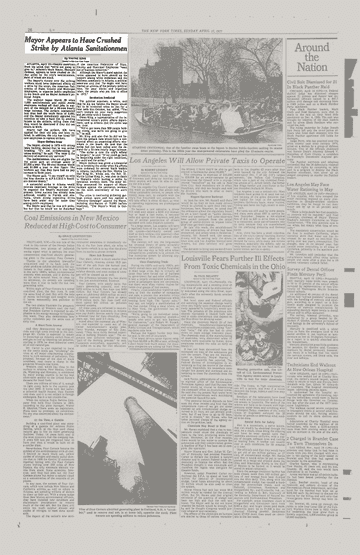 NEW YORK TIMES 1977 - Mayor Appears to Have Crushed Strike by Atlanta Sanitationmen
NEW YORK TIMES 1977 - Mayor Appears to Have Crushed Strike by Atlanta Sanitationmen
By mid-April, morale among strikers was faltering. Many
reapplied for their old jobs, forced into the humiliating position of standing
in line with scabs. A few rallies were still held, with one on April 12th
seeing garbage dumped on the steps of city hall, resulting in the arrests of a
number of protesters. Picket lines continued to thin out that week, to the
point where only 300 of the original thousand-plus workers stayed out. Though small in numbers, they continued
to rally.
Community support did exist in tiny numbers, even including
a few prominent figures from the civil rights era. One was CORE co-founder
James Farmer who served as director of the Coalition of American Public
Employees at the time. Farmer had supported Jackson, but was perplexed by his
tactics.[18] Another was Rev. James Lawson, a community leader in the 1968
Memphis strike. He compared Jackson to Henry Loeb. The Coalition of Black Trade
Unionist (CBTU) also supported the sanitation workers, chastising Jackson for using “Black workers as political pawns in his efforts to please a middle
class black political constituency and satisfy the black establishment.”[19]
Conclusion
Atlanta and other major U.S. cities like Detroit and
Washington D.C., where black officials are in the majority, have entrenched a system of ethnic patronage that is
fundamentally wrought under the weight of white supremacy. This system
rewards elites of all ethnic backgrounds who preside over city councils,
chambers of commerce, civic organizations, and union bureaucracies at the
expense of everyday working folks. In majority black cities like Atlanta, it is
black officials, in concert with the network of white business and civic
elites, who see to it their social and economic plans for the city go forward
with little or no challenge.
When individuals
or groups, like city sanitation workers did in 1977 Atlanta, struggle against
those who would see them as little more than spoiled, misbehaving children
asking for more than what little the bosses think they are worth, then all of
official society works to shut them down.
In Memphis, sanitation workers were able to flip the table
over on white supremacist social relations at work and in the community for a
time. This was not the case in Atlanta, where just seven years earlier
sanitation workers were supported by black civil rights establishment figures
as upholding the legacy of Memphis sanitation workers in their workplace and
community struggle against white supremacy. And yet those same establishment figures, now hailed as mayors,
councilpersons, civic and union leaders, portrayed the self-activity of these
Atlanta sanitation workers as a threat to the fabric of the community,
endangering the gains of the Civil Rights and Black Power movements that made
black officialdom a reality in the heart of Jim Crow.
The 1977 strike demonstrates that, no matter the background
of city bosses, working folks take a back seat to the social and economic
interests of ruling and aspiring progressive elites. With few people and groups
willing to challenge the power of today’s supposedly progressive overseers, the proud tradition of battle against white
supremacy and workers self-management in places like Memphis, Atlanta, and
throughout America during the Civil Rights and Black Power era seems like a
fleeting memory.
This scenario continues to this day in Atlanta, where labour
struggles by unionized and non-unionized workers in majority black workplaces
must battle black corporate and government bosses. A good example is the organizing by rail and bus operators for
Atlanta’s public transit system (MARTA) in 2005. They sought better pay and
benefits, and more control of workplace conditions. Their demands were blocked
at every turn by MARTA’s board,
consisting predominantly of black corporate and civic figures, even some
with ties to the old civil rights establishment that played a hand in crushing
the 1977 strike. MARTA workers were eventually forced to accept a largely
unfavorable contract, handed down by a judge, which saw many health benefits
and workplace control sacrificed for a very modest raise.
Time will tell when
everyday folks will finally be able to completely break through, tearing off
the progressive veneer used by today’s coalitions of ruling elites to cover
over the fundamental social, racial, and economy inequalities they carry on.
Originally published in New Beginnings, A Journal of Independent Labor
Notes
[1]See Godshalk, David
Fort. Veiled Visions: The 1906 Atlanta Race Riot and the Reshaping of American
Race Relations. Chapel Hill, North Carolina: University of North Carolina
Press, 2005; Burns, Rebecca. Rage in the Gate City: The Story of the Atlanta 1906
Race Riot. Cincinnati: Emmis Books, 2006; and Bauerlein, Mark. Negrophobia: A
Race Riot in Atlanta, 1906. San Francisco: Encounter Books, 2001.
[2]At the River I
Stand. Dir. David Appleby. DVD. 1993. San Francisco: California Newsreel, 2004.
56min.; Beifuss, Joan Turner. At the River I Stand. Memphis: St. Luke’s Press,
1990; Green, Laurie B. “Battling the Plantation Mentality: From the Civil
Rights Act to the Sanitation Strike.” In Battling the Plantation Mentality:
Memphis and the Black Freedom Struggle. Chapel Hill, North Carolina: University
of North Carolina Press, 2007, 251-287; Honey, Michael K. Going Down Jericho
Road: The Memphis Strike, Martin Luther King’s Last Campaign. New York: W.W.
Norton, 2007.
[3]Beifuss, Joan
Turner. At the River I Stand. 40.
[4]Ibid, 25.
[5]“City Employees in
Atlanta Vow to Escalate Strike.” New York Times (22 March 1970): 29.
[6]“1,400 Striking
City Employees In Atlanta Discharged by Mayor” New York Times (21 March 1970):
20, and McCartin, Joseph A. “‘Fire the Hell Out of Them”: Sanitation Workers’
Struggles and the Normalization of the Striker Replacement Strategy in the
1970s.” Labour: Studies in Working-Class History of the Americas 2.3 (2005):
70.
[7]Reed, Jr., Adolph.
“The Jug and Its Contents.” In Stirrings in the Jug: Black Politics in the
Post-Segregation Era. Minneapolis: University of Minnesota Press, 1999. 5. See
also Reed’s “Why Is There No Black Political Movement?” In Class Notes. New York:
The New Press, 2000. 3-9.
[8]Bell, Chuck and Jay
Lawrence. “City Workers Take Day Off.” Atlanta Constitution (8 February 1977):
10-C, and Lawrence, Jay and Valerie Price. “Garbage Workers on Strike.” Atlanta
Constitution (9 February 1977): 1-A, 1-F.
[9]Lawrence, Jay.
“Garbage Workers Back; Question Is, Who Won What?” Atlanta Constitution (15
February 1977): 8-B.
[10]Matthews, Tom and
Vern E. Smith. “Atlanta: The Strikebreaker.” Newsweek (25 April 1977): 29.
[11]“The Mayor and the
$28 Million. A Mystery Story.” Atlanta Constitution (8 April 1977), and New
York Times (27 March 1977).
[12]McCartin, 85, and
Martin, Lyn. “Protestors Dump Trash At City Hall.” Atlanta Constitution (13
April 1977): 1-A, 10-A.
[13]Numerous books
document the history of radical community and national groups being normalized
into positions of governance. See Komozi Woodard’s A Nation Within a Nation:
Amiri Baraka (LeRoi Jones) and Black Power Politics about CAP in Newark.
[14]Reed, Jr., Adolph.
“The Jug and Its Contents.” In Stirrings in the Jug: Black Politics in the
Post-Segregation Era. 8-9.
[15]McCartin, 67.
[16]“Fire the
Strikers.” Atlanta Constitution (30 March 1977): 4-A, and Atlanta Daily World
(4, 7 April 1977).
[17]Lawrence, Jay.
“City Strikers Clash With Job Applicants.” Atlanta Constitution (5 April 1977):
2-A, and “Strike is Criticized by Dr. King’s Father.” New York Times (5 April
1977): 5.
[18]Matthews, Tom and
Vern E. Smith, Newsweek (25 April 1977): 29.
[19]McCartin, 86.

